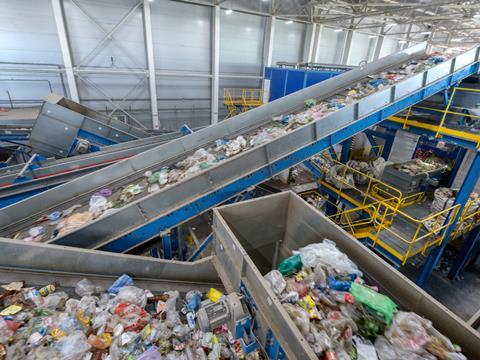
AIM, the European Brands Association, and the Alliance to End Plastic Waste announced today a partnership to start semi-industrial trials in the next phase of the HolyGrail 2.0 project, which is testing digital watermarks for the intelligent sorting of packaging waste.
The organisations will work with the City of Copenhagen to conduct the next phase of the pilot. Over the next four months, a prototype sorting detection unit will be installed at the Amager Resource Centre (ARC) in Copenhagen, where the trials and demonstrations with around 125,000 pieces of packaging representing up to 260 different stock-keeping units (SKUs) will be held.
Engineers will test for several parameters including the speed and accuracy of the system, with the objective of ensuring its ability to withstand the pressures of full-scale industrial operations. If successful, digitally watermarked products could reportedly be introduced to store shelves in Denmark, France and Germany by the first half of 2022 for in-market demonstrations and industrial-scale trials.
Digital watermarks are imperceptible codes, each the size of a postage stamp. They cover the surface of a consumer goods packaging and carry a wide range of attributes such as packaging type, material and usage.
Used packaging is collected and scanned on the sorting line with a high-resolution camera which detects and decodes the digital watermark.
The packaging is then sorted into corresponding streams, based on specified attributes including food, non-food or polymer types. This leads to more accurate sorting streams and higher quality recyclates to be channelled back into the plastic packaging value chain.
Open Houses comprising a virtual tour and demonstration of the prototype sorting detection unit will happen at ARC on 19 October and 18 November 2021 – interested stakeholders can register here.
This milestone marks the second year of the HolyGrail 2.0 project. Since its launch in September 2020, it has grown to include over 130 participating companies and organisations across the complete packaging value chain. The previous iteration of the project, which won the top prize at Packaging Europe’s Sustainability Awards 2019, was facilitated by the Ellen MacArthur Foundation between 2016 and 2019.
“We are delighted to enter the next phase of semi-industrial testing within the Digital Watermarks Initiative together with our new partner, the Alliance to End Plastic Waste”, says Michelle Gibbons, AIM’s director general.
“An initiative like this can only thrive with the wide support of different key stakeholders in terms of expertise, but of course also financial support. Collaboration is the way forward to achieve the EU’s circular economy goals and we are confident that this technology has the potential to drive a truly circular economy for packaging.”
With the commencement of semi-industrial trials, the organizations behind HolyGrail 2.0 say that they are on track to get to the phase of in-market demonstrations planned for 2022.
Two machine vendors, Pellenc ST and Tomra, together with the selected digital watermarks technology provider Digimarc, are developing add-on modules for their detection sorting units, to be combined with existing NIR (near infra-red) sorters.
Both modules will be tested during the semi-industrial phase via trials at two different test locations. The first controlled tests using industrial-sized equipment and the Pellenc ST/Digimarc module are scheduled for October 2021 at ARC sorting centre.
Pending successful completion of the semi-industrial trials, brand owners and retailers will then bring their enhanced products to market in Denmark, France and Germany. During this commercial test phase, consumers will buy on-shelf products with digitally watermarked packaging.
Used packaging will enter the waste stream after consumption. The sorting units will be placed in five different locations in France and Germany, including MRFs (materials recovery facilities), PRFs (plastic recovery facilities) and recycling plants.
This last phase is scheduled to run until Q3 2022, and a public report outlining the techno-economic analysis of the digital watermark technology for sorting of packaging waste will also be issued at this point.











